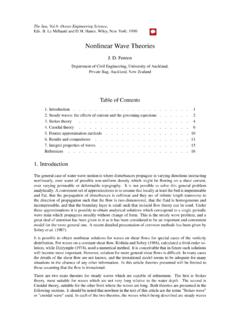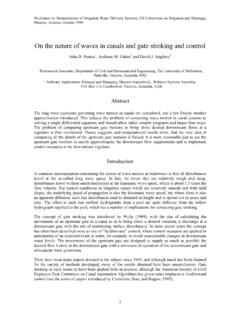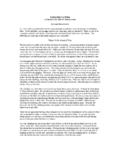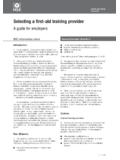Transcription of A First Course in Hydraulics - John Fenton Homepage
1 February 15, 2012. A First Course in Hydraulics John Fenton Abstract This Course of lectures is an introduction to Hydraulics , the traditional name for fluid mechanics in civil and environmental engineering where sensible and convenient approximations to apparently- complex situations are made. An attempt is made to obtain physical understanding and insight into the subject by emphasising that we are following a modelling process, where simplicity, insight, and adequacy go hand-in-hand. We hope to include all important physical considerations, and to exclude those that are not important, but with understanding of what is being done. It is hoped that this will provide a basis for further sophistication if necessary in practice if a problem contains unexpected phenomena, then as much advanced knowledge should be used as is necessary, but this should be brought in with a spirit of scepticism.
2 Table of Contents References .. 4. 1. The nature and properties of fluids, forces, and flows .. 5. Properties of fluids .. 5. Forces acting on a fluid .. 12. Units .. 12. Turbulent flow and the nature of most flows in Hydraulics .. 12. 2. Hydrostatics .. 22. Fundamentals .. 22. Forces on submerged planar objects .. 28. Forces on submerged boundaries of general shape .. 31. The buoyancy and stability of submerged and floating bodies .. 36. 3. Fluid kinematics and flux of quantities .. 41. Kinematic definitions .. 41. Flux of volume, mass, momentum and energy across a surface .. 42. Control volume, control surface .. 44. 4. Conservation of mass the continuity equation .. 44.
3 5. Conservation of momentum and forces on bodies .. 45. 6. Conservation of energy .. 50. The energy equation in integral form .. 50. Application to simple systems .. 52. Bernoulli's equation along a streamline .. 54. 1. A First Course in Hydraulics John Fenton Crocco's law a generalisation of Bernoulli's law .. 56. Irrotational flow .. 58. Summary of applications of the energy equation .. 59. 7. Dimensional analysis and similarity .. 59. Dimensional homogeneity .. 59. Buckingham theorem .. 59. Useful points .. 60. Named dimensionless parameters .. 62. Physical scale modelling for solving flow problems .. 63. 8. Flow in pipes .. 64. The resistance to flow .. 64. Practical single pipeline design problems.
4 68. Minor losses .. 69. Pipeline systems .. 71. Total head, piezometric head, and potential cavitation lines .. 73. 9. Discharge measurement in pipes .. 86. Differential head meters Venturi, nozzle and orifice meters .. 86. Acoustic flow meters .. 89. Magnetic Flowmeters .. 90. 10. Pressure surges in pipes .. 90. Introduction .. 91. The phenomenon of water hammer .. 91. Sequence of events following sudden valve closure .. 91. Derivation of fundamental relationship using steady momentum theorem .. 93. Practical considerations .. 94. 11. Pumps and turbines .. 95. Introduction to pump types .. 95. hydraulic ram pumps .. 96. Centrifugal Pumps .. 97. Pump Performance Curves/Characteristic Curves.
5 98. Dimensional analysis .. 99. Similarity laws .. 101. Series and parallel operation .. 102. Euler equation for a rotor (impeller) .. 103. Water turbines .. 105. 2. A First Course in Hydraulics John Fenton Useful reading and reference material Historical works Garbrecht, G. (ed.) (1987) Hydraulics and hydraulic research: a historical An encyclopaedic historical review, Rotterdam ; Boston : Balkema overview Rouse, H. and S. Ince (1957) History of Hydraulics , Iowa Institute of hydraulic An interesting readable history Research, State University of Iowa Standard fluid mechanics & Hydraulics textbooks Douglas, , Gasiorek, and Swaffield (2001) Fluid mechanics, Pear- Standard Hydraulics textbook son Education Francis, and P.
6 Minton (1984) Civil engineering Hydraulics , E. Arnold A clear and brief presentation Featherstone, , and C. Nalluri (1995) Civil engineering Hydraulics : essen- Practically-oriented, with examples tial theory with worked examples, Blackwell Science Rouse, H. (1946) Elementary mechanics of fluids, Wiley Clear and high-level explanation of the basics Street, R. L., G. Z. Watters, and J. K. Vennard (1996) Elementary fluid mechan- Standard Hydraulics textbook ics, Wiley Streeter, V. L., and E. B. Wylie (1998) Fluid mechanics, McGraw-Hill Standard Hydraulics textbook White, F. M. (2003) Fluid Mechanics, Fifth edn, McGraw-Hill Standard Hydraulics textbook Worked solutions Alexandrou, A.
7 N. (1984) Solutions to problems in Streeter/Wylie, Fluid me- chanics, McGraw-Hill Douglas, John F (1962) Solution of problems in fluid mechanics,Pitman Paper- backs Books which deal more with practical design problems of more use in later semesters Chadwick, A. and J. Morfett (1993) Hydraulics in civil and environmental en- Practice-oriented gineering, EFN Spon Mays, L. W. (editor-in-chief) (1999) hydraulic design handbook, McGraw-Hill Encyclopaedic, and outside this Course Novak, P. et al. (1996) hydraulic structures, Spon Practice-oriented Roberson, J. A., J. J. Cassidy, M. H. Chaudhry (1998) hydraulic engineering, Practice-oriented Wiley Sharp, (1981) hydraulic modelling, Butterworths For modelling and dimensional similitude 3.
8 A First Course in Hydraulics John Fenton References Batchelor, G. K. (1967), An Introduction to Fluid Dynamics, Cambridge. Colebrook, C. F. (1939), Turbulent flow in pipes with particular reference to the transition region between the smooth and rough pipe laws, J. Inst. Civ. Engrs 11, 133 156. Colebrook, C. F. & White, C. M. (1937), Experiments with fluid friction in roughened pipes, Proc. Roy. Soc. London Ser. A 161, 367 381. Fenton , J. D. (2002), The application of numerical methods and mathematics to hydrography, in Proc. 11th Aus- tralasian Hydrographic Conference, 3 July - 6 July 2002', Sydney. Fenton , J. D. (2005), On the energy and momentum principles in Hydraulics , in Proc.
9 31st Congress IAHR, 11-16 September', IAHR, Seoul, pp. 625 636. Haaland, S. E. (1983), Simple and explicit formulas for the friction factor in turbulent pipe flow, J. Fluids Engng 105, 89 90. Montes, S. (1998), Hydraulics of Open Channel Flow, ASCE, New York. Moody, L. F. (1944), Friction factors for pipe flow, Trans. ASME 66, 671 684 (including discussion). Rouse, H. (1937), Modern conceptions of the mechanics of fluid turbulence, Trans. ASCE 102(1965 (also published in facsimile form in Classic Papers in Hydraulics (1982), by J. S. McNown and oth- ers, ASCE)), 52 132. Sharp, B. B. (1981), Water Hammer, Edward Arnold. Streeter, V. L. & Wylie, E. B. (1981), Fluid Mechanics, First si metric edn, McGraw-Hill Ryerson, Toronto.
10 Swamee, P. K. & Jain, A. K. (1976), Explicit equations for pipe-flow problems, J. Hydraulics Div. ASCE 102, 657 . 664. White, F. M. (2003), Fluid Mechanics, fifth edn, McGraw-Hill, New York. 4. A First Course in Hydraulics John Fenton 1. The nature and properties of fluids, forces, and flows Properties of fluids Definition of a fluid (a) Liquid (b) Gas (c) Liquid with other molecule Figure 1-1. Behaviour of typical molecules (a) of a liquid, (b) a gas, and (c) a different molecule in a liquid A fluid is matter which, if subject to an unbalanced external force, suffers a continuous deformation. The forces which may be sustained by a fluid follow from the structure, whereby the molecules are able to move freely.
















